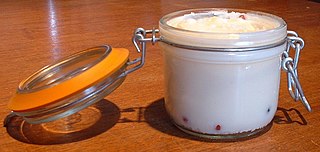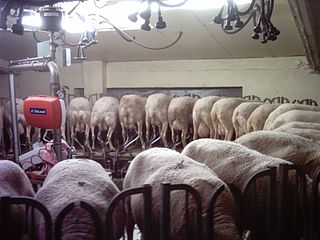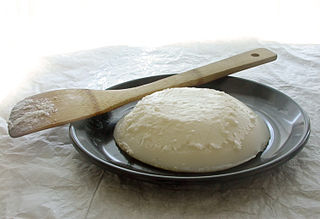Artificial marbling is the injection of animal fat or vegetable oil into lean meat in order to simulate the appearance of marbling and attempt to improve the palatability of inexpensive cuts by preventing them from drying out or losing flavour during the freezing or cooking process. Lean cuts of beef are one common target of artificial marbling. [1] The process may also be performed on pork. It has been described as a more technologically advanced form of larding. [2]
The Agri-Food and Veterinary Authority of Singapore labels artificially marbled beef as "beef tallow-injected further processed beef". [3] Hokubee Australia markets its fat-injected beef product under the brand name Meltique, though its halal products use canola oil instead of fat, due to concerns about cross-contamination with pork tallow. [4] [5]
The United States Department of Agriculture requires that when fats and oils are added to red meat products such as roast beef and steaks, the product indicate this prominently, for example as part of the product name or as a product name qualifier. Additionally, products that appear to be of a higher quality as a result of fat injections must include a statement to indicate this, such as "injected with beef fat", "artificially marbled—simulated fat covered", or "product may appear to be of a higher quality than the actual grade". [6]
Some businesses have taken advantage of the improved appearance in an attempt to pass it off as the higher-quality naturally marbled meat, especially in environments such as restaurants, where the meat's packaging and labelling are not visible to customers. [1]
A variety of injectants may be used to create artificial marbling. The injectant may be pure fat (such as tallow) heated to a high temperature to melt it while sufficiently cool so as not to cook the meat when injected, fat suspended in an emulsifier, fat blended with vegetable oils, or fatty acids such as conjugated linoleic acid (CLA) in powder form.
Research into artificial marbling through fat injection was carried out as early as the 1960s. [7] A 1999 Polish study found that fat-injected horse meat tended to retain more flavour than non-injected control samples after two-week and three-month periods of cold storage. [8] Another 2007 U.S. study by Tyson Foods and the University of Arkansas used beef strip loin and injected it with conjugated linoleic acid (CLA) in powder form, or oil with high concentration of CLAs. Under visual assessment by independent panelists, the USDA marbling score of the powder-treated meat increased by two levels. The powder-treated meat tended to be juicier than the oil-treated meat after cooking, but otherwise the injected meat had similar colour and flavour to the untreated meat. [9] A 2017 study from West Texas A&M University found that the injection of beef loins with pork back fat resulted in higher consumer preference scores for juiciness and overall preference. Cooked steaks injected with pork fat had a lower moisture content but higher fat content, and trained panelists could detect an "off aroma." [10]

Ham is pork from a leg cut that has been preserved by wet or dry curing, with or without smoking. As a processed meat, the term "ham" includes both whole cuts of meat and ones that have been mechanically formed.

Salami is a cured sausage consisting of fermented and air-dried meat, typically pork. Historically, salami was popular among Southern, Eastern, and Central European peasants because it can be stored at room temperature for up to 45 days once cut, supplementing a potentially meager or inconsistent supply of fresh meat. Countries and regions across Europe make their own traditional varieties of salami.

Tallow is a rendered form of beef or mutton suet, primarily made up of triglycerides.

Stearic acid is a saturated fatty acid with an 18-carbon chain. The IUPAC name is octadecanoic acid. It is a soft waxy solid with the formula CH3(CH2)16CO2H. The triglyceride derived from three molecules of stearic acid is called stearin. Stearic acid is a prevalent fatty-acid in nature, found in many animal and vegetable fats, but is usually higher in animal fat than vegetable fat. It has a melting point of 69.4 °C and a pKa of 4.50.

Beef aging or ageing is a process of preparing beef for consumption by aging it, in order to break down the connective tissue within the meat.
Rendering is a process that converts waste animal tissue into stable, usable materials. Rendering can refer to any processing of animal products into more useful materials, or, more narrowly, to the rendering of whole animal fatty tissue into purified fats like lard or tallow. Rendering can be carried out on an industrial, farm, or kitchen scale. It can also be applied to non-animal products that are rendered down to pulp. The rendering process simultaneously dries the material and separates the fat from the bone and protein, yielding a fat commodity and a protein meal.

Conjugated linoleic acids (CLA) are a family of isomers of linoleic acid. In principle, 28 isomers are possible. CLA is found mostly in the meat and dairy products derived from ruminants. The two C=C double bonds are conjugated. CLAs can be either cis-fats or trans-fats.

Charcuterie is a French term for a branch of cooking devoted to prepared meat products, such as bacon, ham, sausage, terrines, galantines, ballotines, pâtés, and confit, primarily from pork.

Marbled meat is meat, especially red meat, that contains various amounts of intramuscular fat, giving it an appearance similar to marble.

Kangaroo meat is produced in Australia from wild kangaroos and is exported to over 60 overseas markets.

Beef cattle are cattle raised for meat production. The meat of mature or almost mature cattle is mostly known as beef. In beef production there are three main stages: cow-calf operations, backgrounding, and feedlot operations. The production cycle of the animals starts at cow-calf operations; this operation is designed specifically to breed cows for their offspring. From here the calves are backgrounded for a feedlot. Animals grown specifically for the feedlot are known as feeder cattle, the goal of these animals is fattening. Animals not grown for a feedlot are typically female and are commonly known as replacement heifers. While the principal use of beef cattle is meat production, other uses include leather, and beef by-products used in candy, shampoo, cosmetics, and insulin.
Vaccenic acid is a naturally occurring trans fatty acid. It is the predominant kind of trans-fatty acid found in human milk, in the fat of ruminants, and in dairy products such as milk, butter, and yogurt. Trans fat in human milk may depend on trans fat content in food.

Conjugated fatty acids is jargon for polyunsaturated fatty acids containing at least one pair of conjugated double bonds. An example of a conjugated fatty acid is the rumenic acid, found in the meat and milk of ruminants. Most unsaturated fatty acids that are doubly unsaturated do not feature conjugation, e.g., linoleic acid and linoelaidic acid.

Potted meat is a form of traditional food preservation in which hot cooked meat is placed in a pot, tightly packed to exclude air, and then covered with hot fat. As the fat cools, it hardens and forms an airtight seal, preventing some spoilage by airborne bacteria. Before the days of refrigeration, potted meat was developed as a way to preserve meat when a freshly slaughtered animal could not be fully eaten immediately.

Sheep's milk is the milk of domestic sheep. It is commonly used to make cultured dairy products such as cheese. Some of the most popular sheep cheeses include feta (Greece), ricotta (Italy), and Roquefort (France).

Lard is a semi-solid white fat product obtained by rendering the fatty tissue of a pig. It is distinguished from tallow, a similar product derived from fat of cattle or sheep.
Happy Cow Creamery is a family-owned dairy farm in Pelzer, South Carolina that bottles and sells its own milk on site from the farm's closed herd of grass-fed Holstein cattle. The creamery's whole milk, buttermilk and chocolate milk is sold in the farm's on-site store and through grocery, convenience and country stores in Upstate region of South Carolina. The milk is not homogenized and is low-temperature pasteurized and inspected by the State of South Carolina.
Pig fat is generally the fat in pork. The fatty acid composition of pork is found to be slightly different from meat of other animals, such as beef and lamb. The proportion of fat in pork can vary from 10–16%, but can be higher depending on the cut and level of trimming, among other factors.
Tenderness is a quality of meat gauging how easily it is chewed or cut. Tenderness is a desirable quality, as tender meat is softer, easier to chew, and generally more palatable than harder meat. Consequently, tender cuts of meat typically command higher prices. The tenderness depends on a number of factors including the meat grain, the amount of connective tissue, and the amount of fat. Tenderness can be increased by a number of processing techniques, generally referred to as tenderizing or tenderization.

Trans fat, also called trans-unsaturated fatty acids, or trans fatty acids, is a type of unsaturated fat that occurs in foods. Trace concentrations of trans fats occur naturally, but large amounts are found in some processed foods. Since consumption of trans fats is unhealthy, artificial trans fats are highly regulated or banned in many nations. However, they are still widely consumed in developing nations, resulting in hundreds of thousands of deaths each year. The World Health Organization (WHO) has set a goal to make the world free from industrially produced trans fat by the end of 2023.